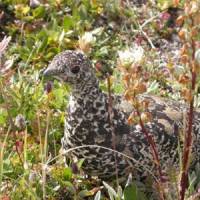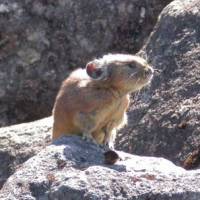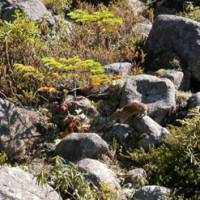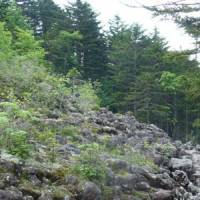Scrambling across hillsides may not be everyone's cup of tea, but we naturalists are determined folk and take such activities in our stride when exploring our environment.
Take the average hillside or mountainside in Japan; what does it consist of? Usually, forested slopes on dark soils, with bare rock exposed here and there. Yet occasionally, an observant and well-traveled hiker may notice loose rocks — not ones recently shattered by winter's freeze-thaw processes, or formed by crashing rock falls — but rounded rocks, weathered and worn, though not as smooth as if they have spent millennia in running water.
Such trekkers might also notice that those loose rocks occur in discrete patches, oddly like a dry-stone garden or short, broad rivers of rocks amid clearings on forested hillsides.
The rocks tend to be covered in lichen and moss; while some shrubs and young trees may also be gaining a toehold in the thin soils accumulating among the mosses. The surrounding forest will eventually claim and overwhelm these rivers of rocks, as it no doubt has many others now hidden beneath deeper soils. In consequence, such habitats — in fact periglacial features that relate to the past presence of ice and frozen ground — become increasingly rare as soils and forests spread.
A jumbled pile of rocks on a mountainside may seem a very odd place to go looking for wildlife — and in most of Japan, however hard you looked, you wouldn't find special mammals associated with them. In certain parts of Hokkaido, though, in the central Daisetsu and Hidaka mountains, not only do such places still survive, but in some of them a strange creature is at home.
Spend a while; take a seat, watch and listen. A sharp half-cry or half-whistle is a hint that something may have emerged. They blend in so well with the weathered rocks and their patina of fine vegetation that it is hard to spot them at first. Then suddenly your eyes adjust and you realize that a small rock has moved. Not rolled, not fallen — moved. It's a northern pika.
This compact creature with short, rounded ears, short limbs and an almost nonexistent tail, pauses, sits still again, raises its head, opens its mouth and releases a high-pitched half-whistle. Its Japanese name is delightful — naki-usagi, meaning "singing or crying rabbit."
Actually, it's not a true rabbit, but a distant relative that grows to between 12 and 19 cm in body length and is in a family of its own named Ochotonidae. In summer, through molting, northern pikas turn somewhat reddish-brown, while in winter they are, apparently, dark grayish-brown. I have never seen them in winter, because most of their particular habitat survives only at heights above 800 meters and up there in Hokkaido everything is deep under snow in winter.
Seemingly pikas, which often live in colonies and are said to have a lifespan of up to 9 years, do not hibernate but remain active beneath the snow, feeding on snow-buried vegetation and stashes of food they gather and store during summer and autumn. In fact, late one summer in Mongolia I once watched pikas making hay — literally. They were gathering bundles of grasses and laying them out on rocky ledges in the sun to dry. In Hokkaido I have seen them gathering autumn leaves and dragging them into crevices under rocks.
There is something remarkably appealing about these creatures, whose larger individuals can weigh up to 200 grams, and it is not surprising that nature photographers in Japan devote almost as much energy to photographing them as they do to capturing images of cranes and monkeys. However, their appeal for me lies not only in their appearance and their behavior, but in the habitat they depend on and what that tells us of the past.
The naki-usagi northern pikas of Hokkaido are known to naturalists as Ochotona hyperborea, and in the Hidaka Mountains they are at the very southern limit of the species' range in East Asia. Quite capable of surviving the harshest of winters Hokkaido can throw at them, they are tough enough to withstand even harsher conditions in northeast Russia, and I have encountered them so far north in northeast Chukotka that they were quite close to the Bering Strait. But northern pikas are survivors in more senses than one — not only in terms of the elements, but also in terms of their habitat.
Those weathered rock piles that they depend on, and which form isolated "islands" of suitable habitat for them, are far more visible the higher up or further north one goes, and when they occur above the tree line they are fully exposed reminders that 15,000 years or so ago, when the world was last in the grip of an extensive Ice Age, sea levels were considerably lower. Back then, the Japanese archipelago had a very different form, with multiple land connections to Asia, including from Hokkaido via Sakhalin to what is now northeast Russia.
Also during that Ice Age, the summer snow line in Japan's mountains was much lower, and the habitats of northern, central and even western Japan were far more like those of parts of eastern Siberia today. As a result, the ranges of species that are now found only much further north then extended further south and west. That was because the forests in those days comprised a mixture of needle-leaved and deciduous trees, and lacked the broadleaved evergreens that dominate central and western Honshu today.
In the dappled light of those forest floors, carpets of dogtooth violets (Erythronium japonicum) spread brightening the spring. In areas where forests couldn't reach in those times, and in rock piles then exposed, pikas ranged freely across Hokkaido.
However, as the Earth's climate has warmed, allowing broadleaved evergreens to spread northward through Honshu, different forests have also spread in Hokkaido and overwhelmed much pika habitat in a process that continues today. As winters become milder and shorter, plants are better able to colonize poorer soils, and pika are losing ground to vegetation.
Consequently, the northern pika of Japan is a relict; it once had a much wider distribution, and today only survives in certain safe refugia such as the one photographed here north of Obihiro in central Hokkaido.
But northern pikas are not the only Ice Age relicts in Japan. My friend, fellow naturalist and writer Chris Cook, has recently been "hunting" another Japanese relict — the rock ptarmigan, known here as raicho.
Once much more widespread and found at lower altitudes in Honshu, this bird's range has contracted and shrunk as it has retreated into the small confines of the only climatic and vegetation zone left that suits it — in high mountains. Chris has had to hike high up into the Japan Alps to locate specimens, yet it is a species I have encountered right down at sea level in northeastern Russia.
What these two widely separated areas share is a similar environment. The high alpine zone of the Japan Alps is cold enough throughout the year to almost exactly resemble the tundra of the Arctic, so in fact it represents Japan's mini-Arctic high in the clouds, and it's that tundralike habitat that ptarmigans thrive in.
Just like the pikas that are now isolated in Hokkaido, Japan's ptarmigans have nowhere else to retreat to in search of such habitat; the mountains simply go no higher. As summers and winters warm, different vegetation colonizes higher into the mountain ranges, different birds and mammals follow, and slowly the tiny pockets of tundralike habitat are disappearing — just as the rare rock piles of Hokkaido are becoming overwhelmed.
One day before too long, both ptarmigans and pikas will not be relicts in Japan, but lost relicts.
Mark Brazil is a naturalist and author who organizes and leads wildlife excursions around Japan by land and sea. Both his latest book, "Field Guide to the Birds of East Asia," and his earlier "A Birdwatcher's Guide to Japan" are available at good bookstores or via [email protected] or his Web site at www.wildwatchjapan.com






















With your current subscription plan you can comment on stories. However, before writing your first comment, please create a display name in the Profile section of your subscriber account page.